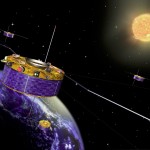Surprise ions
A high-flying satellite reveals a crowd of charged particles in the magnetosphere

Earth’s magnetic field does more than tell compasses which way to point. Stretching thousands of miles into space, it also buffers our planet from the solar wind, an energetic stream of particles from the sun. Strong bursts of solar wind can change the shape of this protective shield, called the magnetosphere, and particle collisions within the region can cause the beautiful, shifting light shows in the sky known as auroras.
Scientists have known for about a hundred years that the magnetosphere also contains positive-charged particles called cold ions. These particles form in a lower layer of Earth’s upper atmosphere and get swept outward to the magnetosphere.
A recent experiment shows that the layer of cold, or low-energy, ions in the magnetosphere is thicker than scientists previously thought. Details of the new experiment, published February 1 in the scientific journal Geophysical Research Letters, show these particles can reside as much as 100,000 kilometers (60,000 miles) overhead. This information can help scientists better understand how events in space affect Earth.
Space physicists Mats André and Chris Cully found the ions almost by accident. The scientists hadn’t gone looking for the particles. They’d been studying data from an instrument onboard a large, spinning, drum-shaped satellite. That satellite swoops in and out of the magnetosphere as it orbits Earth. It is one of four identical satellites that make up CLUSTER, a project by the European Space Agency to study the near edge of outer space.
The cold-ion data were collected between 2006 and 2009, when the satellite bobbed in and out of the magnetosphere hundreds of times. But the measurements didn’t look right, says André.
Sticking out from the spinning center of the satellite are long wire arms that drag through space. André and Cully were studying changes in the electric field between two wires, but something seemed off. Sometimes the measurements lined up with what André and his colleagues expected; other times the electric field was unexpectedly strong.
“Part of the time, everything seemed okay, but then sometimes we thought, ‘This can’t be real,’” says André. They tried to solve the problem by troubleshooting — with no luck. “We tried to think of things that could be wrong,” he says, “but we couldn’t figure out the right thing that was wrong.”
Eventually, the scientists decided that the instrument wasn’t broken. They realized that the changes could be explained by a large number of cold ions surrounding the satellite. As the satellite zooms through a cloud of cold ions, the particles stream past and alter the electric field between the wires.
Most people wouldn’t think of cold ions as “cold,” since their energy translates to a temperature of roughly 500,000 degrees Celsius (or a million degrees Fahrenheit). But these particles are cold compared to ions emitted by the sun, whose high energies make them about 1,000 times hotter than the so-called cold ones.
Cold ions had been hard to detect because no instrument in the magnetosphere could measure the particles without pushing them away. Now, by using electric-field measurements, scientists will be able to study and better understand these particles.
André says the same approach can be used to study cold ions around other planets, which is one of his next projects.
It’s now easy to see the cold ions’ effects on the satellite’s magnetosphere measurements, he says, even though it was vexing at the time.
“It’s a good discovery in the sense that afterwards it’s obvious how it works,” says André. He says that when he presents his findings about the cold ions to his colleagues, “They go, ‘Yeah, of course.’ But it took us months of struggling to figure it out.”
POWER WORDS (adapted from the New Oxford American Dictionary)
solar wind The continuous flow of charged particles from the sun that permeates the solar system.
electric field The electric field is the space where one charged particle can make another move closer or farther away. Charged objects, which have charged particles on the surface, can also make other charged objects move.
atom The basic unit of a chemical element. An atom has a nucleus, which may include particles called protons and neutrons. Surrounding the nucleus is a cloud of electrons, which are negatively charged particles.
ion An atom with an electric charge due to its having lost or gained one or more electrons.
magnetosphere The region surrounding Earth (or another astronomical body) in which its magnetic field protects the planet from the solar wind.







